In this issue
ACCE News
Newsletter of the American College of Clinical Engineering
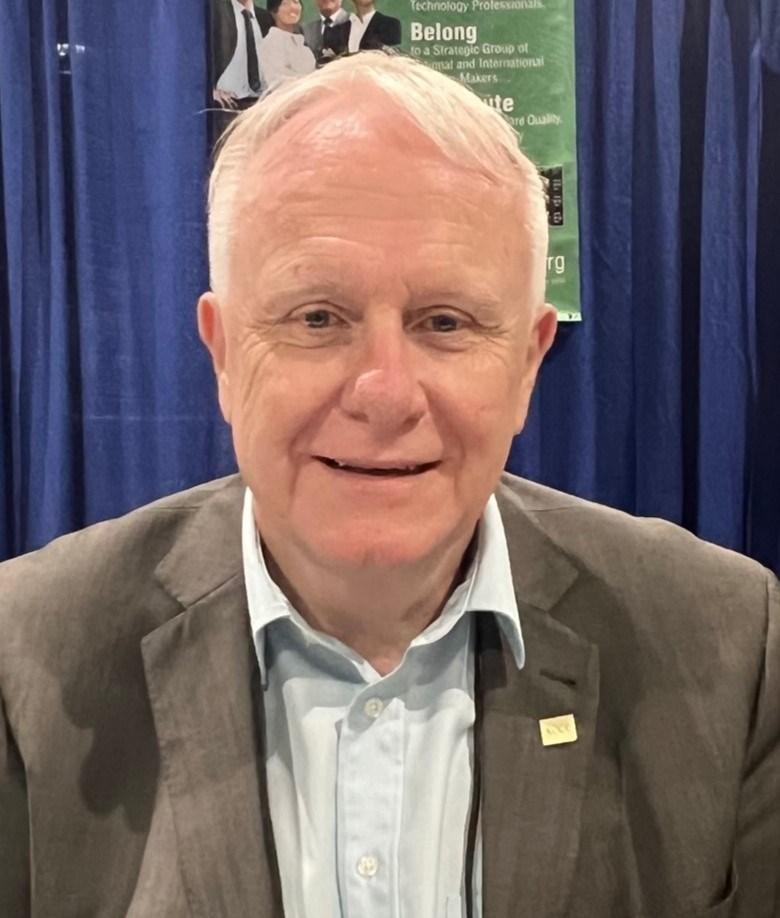



President’s Message
The fall season is upon us and I hope all of you were able to take some time off to spend with your loved ones over the summer months. We installed our new Board of Directors on August 18th and we look forward to rolling out our workplan in the coming months. Six board members are carrying on in their same capacity as in 2022-23: Michele Manzoli as Secretary, Bhaskar Iduri as Treasurer (2nd Term), and Jim Panella, Kevin Kreitzman, Erin Sparnon and Ashley O’Mara as Board Members-at-Large. Moving into new positions this year are Katherine Navarro as President-Elect, Qusai Shikari as VicePresident, Ilir Kullolli as Immediate Past President for an extra term, and myself as President. I believe our leadership team brings a wealth of experience that will support the ACCE well in the coming year. I would like to take a moment to thank outgoing board member Arif Subhan, Immediate Past President, for his past and ongoing contributions to the ACCE in his various roles on the Board and committees.
We are in the process of finalizing our workplan for 2023-24. High on the list will be updating our website. Initial investigation on this task is already underway through an ad-hoc working group. Along with the refresh of our website, we will examine whether our current name and logo should change to reflect today’s realities, recognizing that our profession has evolved significantly over the last thirty years. Our membership has expanded beyond the United States and Canada since that time and on the horizon there is some interest in adding additional Boards of Examiners. We will have initial discussions over the coming months, then draft a proposed plan to rebrand our organization. The plan would then be brought to the ACCE membership for ratification.
Our ten-part CCE Review Webinar series, which started in August, will wrap up on October 11th. I wish this year’s cohort of CCE candidates all the best as they prepare for their upcoming exams. The ACCE educational webinar series will continue throughout the year on a monthly basis with wide ranging topics of interest. This fall’s topics include: Wearables and Value-Based Care, Cybersecurity Passive Monitoring Systems, CMMS Success Stories, and Tips for Refreshing your Medical Equipment Management Plan. Please take the time to register for these sessions which are free to all ACCE members thanks to our 2023-2024 co-sponsors: PYCUBE,
President’s Message (continued)
A special thanks to all our volunteer webinar presenters and organizers that take many hours of their personal time to prepare and deliver these webinars. This work goes a long way to supporting our profession.
Please keep in mind that World CE Day will commence on October 21st and ACCE activities will continue until the 26th. Keep an eye out on the ACCE website for upcoming activity details.
Kim Greenwood, ACCE President greenwood@cheo.on.caACCE News
ACCE News is the official newsletter of the American College of Clinical Engineering (ACCE).
Managing Editor
Ted Cohen tedcohen@pacbell.net
Co-Editors
Ted Cohen tedcohen@pacbell.net
Sonja Markez sonja.markez@gmail.com
Circulation & Address Corrections
Suly Chi, ACCE Secretariat Secretariat@accenet.org
Advertising
Dave Smith davesmithmailbox@gmail.com
VA Announces New HTM Executive Leadership
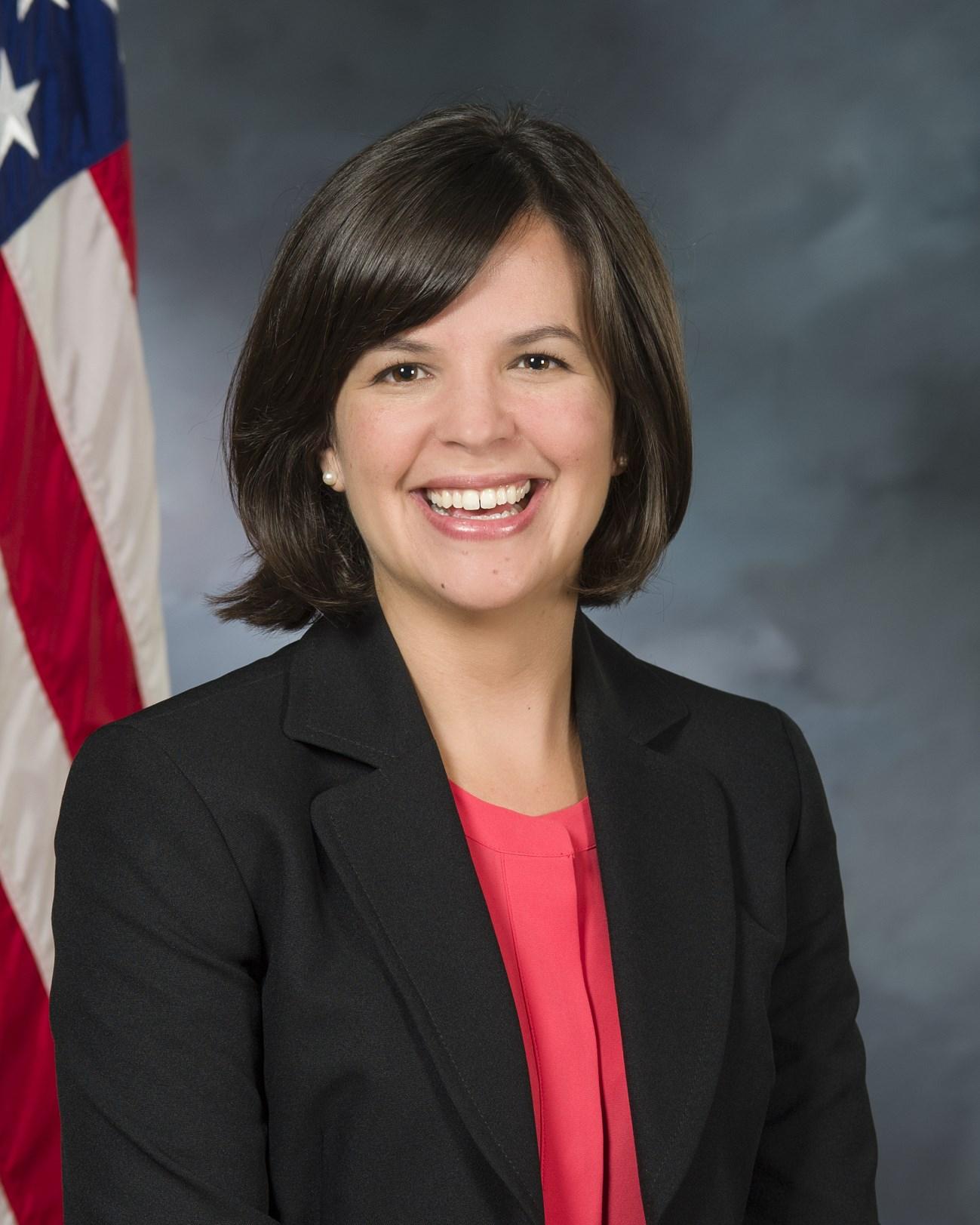
ACCE News is a benefit of ACCE membership; nonmembers may subscribe for $75 per year.
To subscribe e-mail Secretariat@accenet.org
Copyright © 2023 by ACCE
The Department of Veterans Affairs (VA) recently named Megan Friel and Michelle Baquie as the Director and Deputy Director, respectively, of the Veterans Health Administration (VHA) Office of Healthcare Technology Management (HTM)
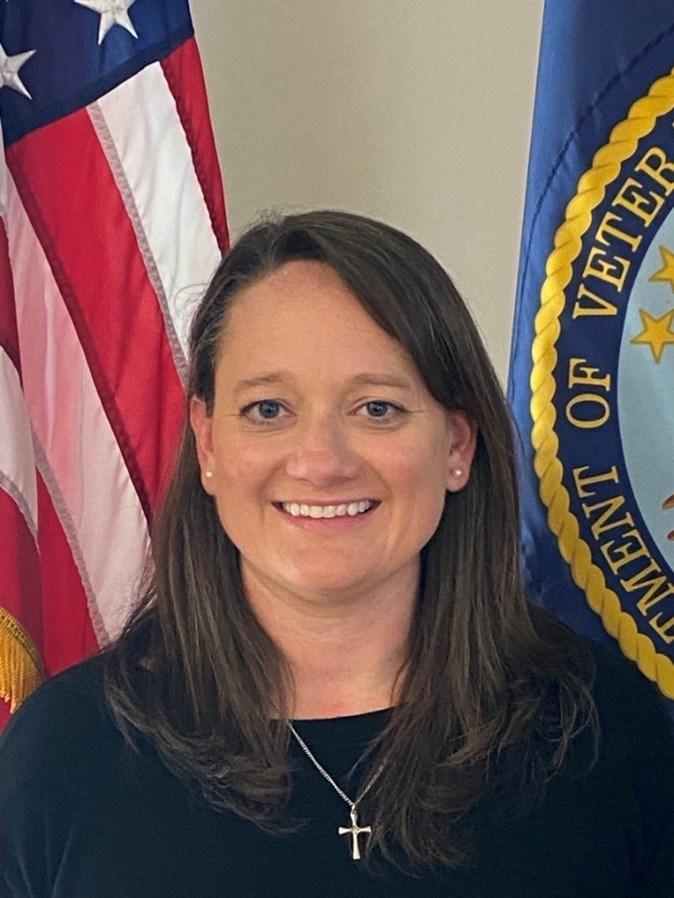
In their roles as the executive leaders of VHA’s HTM program, Ms. Friel and Ms. Baquie provide oversight of Biomedical Engineering and the management of medical technology across the Veterans Health Administration consistent with applicable laws, regulations, industry standards, accreditation requirements, and VA policies. Along with their team in the Office of HTM, they strive to manage variation, reduce risk, and spread strong practices to improve the performance of field HTM programs and to ensure medical equipment safety, reliability, and availability for patient care. Their oversight applies to HTM programs in all Veterans Integrated Service Networks (VISNs), VA Medical Centers (VAMCs), and VHA’s central office –more than 150 distinct programs nationwide. Collectively, VHA HTM programs directly manage 900,000 medical devices worth $10 billion,
with a field workforce of approximately 1,800 individuals.
Before her permanent placement as Director, Ms. Friel served in an interim capacity for 20 months, from August 2021. She brings nearly 20 years of VHA HTM experience, including over a decade as the Associate Director of HTM. In this role she led numerous national programs and initiatives including the Medical Device Protection Program and Biomedical Engineering operations.
Most recently, Ms. Baquie acted as the Office of HTM’s Director of Operations. She joined the VA in 2004 and the Office of HTM in 2009 where she led the awardwinning Biomedical Engineering Technical Career Field (TCF) Program and HTM Professional Development Program.
Congratulations to these two ACCE members for their new roles in one of the largest CE/HTM organizations in the world.
CCE Exam Prep: Sample Review Questions
In this column we are providing sample questions and information regarding preparation for the CCE exam. The sample questions are based on topics from the ACCE Body of Knowledge survey and the CCE Study Guide, version 12. Note that the instructors for the ACCE CCE Prep courses, and the writers for this column, do NOT have any affiliation with the CCE Board of Examiners and have no access to the actual exam questions. If you have specific topics you would like us to cover please contact editor@accenet.org.

Codes and Standards (CE Certification Study Guide, Version 12, section 5.1e)
Question 1: Which edition of NFPA 99 is officially recognized by CMS and TJC?
A. 2021 Edition
B. 2018 Edition
C. 2015 Edition
D. 2012 Edition
Correct answer: D: 2012 Edition
Question 2: In the 2012 Edition of NFPA 99, how often are hospitals required to do leakage current and ground testing on patient care -related electrical equipment within patient care rooms?
A. Every six months
B. Every 12 months
C. As specified by the manufacturer
D. Before being put into service for the first time, and after any repair or modification that might have compromised electrical safety
Correct answer: D (see section 10.5.2.1.2)
Question 3: Regarding the IEC 60601 series of standards, what is the difference between “Collateral Standards” and “Particular Standards”? (May be more than one correct answer!)
A. Collateral Standards are horizontal standards, and Particular Standards are vertical standards
B. Collateral Standards are vertical
standards, and Particular Standards are horizontal standards
C. Collateral Standards cover topics not fully covered by the general standard (IEC 60601-1)
D. Particular Standards are intended to tailor the requirements of the series to a specific equipment type.
Correct answer: A, C and D
Explanations
The Centers for Medicare & Medicaid Services (CMS) require health care facilities in the United States to comply with the 2012 edition of NFPA 99. [NOTE: Except for Chapter 7 (Information Technology and Communications Systems for Health Care Facilities), Chapter 8 (Plumbing), Chapter 12 (Emergency Management), and Chapter 13 (Security Management)]
Clinical Engineers should pay particular attention to the following NFPA 99 Chapters: Chapter 1 Administration (for a general understanding of document), Chapter
3 Definitions (to understand the meaning of terms used in the document), Chapter
4 Fundamentals (to understand which portions of the Code apply to different areas within a hospital), Chapter 10 Electrical Equipment, Chapter 11 Gas Equipment, and Chapter 12 Emergency Management.
At some point, CMS is likely to adopt one of the later editions of NFPA 99, which is revised and released every three years. NFPA and the user community do not know when (or if) CMS will do so. Later versions of NFPA 99 after the 2012 edition have made multiple changes to sections within the Code, but the overall structure is like the 2012 edition.
NOTE: The following sections come directly from Setting Standards: The IEC 60601 Series: Quick-Use Guide published in BI&T May 2020:
IEC 60601 is a series of international standards covering Medical Electrical Equipment (MEE) that has been adopted by almost every country in the world.
IEC 60601-1 is the core of the series. The general standard, as it is commonly known, defines the scope and basic con-
tent/structure for all other parts of the series. This part of the series is applicable to all MEE.
The collateral standards are numbered in the format IEC 60601-1-X. The collateral standards, often called horizontal standards, cover topics that may be applicable to all MEE based on the design of the equipment but are not covered by the general standard. Examples include electromagnetic disturbances (IEC 60601-1-2), usability (IEC 606011-6), and alarm systems (IEC 60601-1-8). With only a few exceptions, these standards serve to define additional requirements for MEEs and Medical Electrical Systems (MESs).
The particular standards are numbered in the format IEC 60601-2-X and IEC 80601-2X. The particular standards, or “part 2s” as they are commonly known, are “vertical standards” that make up perhaps the most important parts of the series. These standards are intended to tailor the requirements of the series to a specific equipment type. Examples include high-frequency surgical equipment (IEC 60601-2-2), noninvasive blood pressure monitors (IEC 80601-2-30), magnetic resonance equipment for medical diagnosis (IEC 60601-2-33), and home light therapy equipment (IEC 60601-2-83). The requirements of these standards take precedence over the requirements of the general standard or the collateral standards, with the intent of creating specific requirements applicable to the MEE covered by the smaller scope of these standards. The particular standards can remove or modify requirements of the general/collateral standards, as well as add additional requirements that would not be appropriate for all MEE. Many of these standards define essential performance for the equipment within their scope.
Jennifer Nichols, CCE jennie_nichols@yahoo.comWelcome New ACCE Members
We welcome our newest members, approved by the Membership Committee, and supported by the Board of Directors:
Congratulations to the following members who were upgraded to Individual Level:
• Katherine Troll, Biomedical Engineer Northeast VA Health Care Clinic
• Ana Paulette Arreygue Chavez Clinical System Engineer Sutter Health
Welcome to our newest Institutional Bronze Member: Mayo Clinic
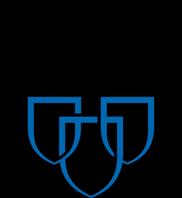
Help Wanted:ACCE News Co-Editor
ACCE News is published six time a year (every other month) and each edition is 10-20 pages long.
The ACCE News co-editor is responsible for editing 3 of these newsletters each year and those duties include the following:
• Notifying regular article contributors of the upcoming edition’s submission deadlines
• Editing submitted articles
• Editing photos and graphics
• Editing newsletter pages so that the articles fit on the page
• Writing headlines and sub-headings
• Submitting draft Newsletter for subsequent review and edit sug-
gestions by the ACCE Secretariat, ACCE President, ACCE Co-editor, and ACCE Managing Editor
• Completing final editing for submission for publishing
• The co-editor may also on occasion write articles
Currently, the software used for this process is Microsoft Publisher.
It takes approximately 10-20 hours per issue to complete the above editor tasks.
If interested, please contact editor@accenet.org
From the Education Committee Desk: October is Cybersecurity Awareness Month
Cybersecurity Passive Monitoring Systems Lessons Learned from HDO and ISO Perspectives

ACCE’s Educational Webinar Series continues this month with the next session on October 12th for Cybersecurity Awareness month. Join our panelists Keith Whitby and Eddie Myers as they share their insights on cybersecurity passive monitoring systems. Keith and Eddie will share tips and lessons learned from HDO and ISO perspectives to help healthcare organizations maximize the utility of these systems. You will learn how to leverage these solutions to enhance your medical device security risk management and vulnerability management programs. Block your calendars on October 12th from 12 – 1PM EDT and make sure to REGISTER for this exciting session today!

Education Committee continued
September’s Webinar Presentation on Wearables
ACCE’s Educational Webinar series in September presented “Wearables and Value-based Care” by cardiologist Dr. Kapil Parakh of Google. Dr. Parakh discussed his views on the use of wearables today and painted a vision of the future of wearable devices and the impact they can make.
Dr. Parakh’s presentation centered around seven points as follows:
Disease Prevention – From a population health perspective, wearables are very important. They motivate people to be more active. For example, studies have shown that every thousand (average) steps is associated with a 25% lower rate of type 2 diabetes Wearables can lead to more steps per day, hence more activity and more weight loss.
Patient Engagement – Patients who use wearables are more likely to take a bigger role in their own care. An example is a device that is worn on the wrist that reminds patients to take medication at the right time. Wearables with appointment reminders can reduce missed appointments which lower healthcare costs, and improve continuity of care. Another particularly interesting use-case was a wearable that, with the consent of the patient, reminded him or her of a poor health indicator, such as elevated baseline heart rate with no activity.
Disease Management – With medical care moving from a fee-for-service to a value-based model, wearables can help improve disease management and hence outcomes. For example, wearables can track blood sugar levels, a key factor in the management of diabetes. A patient can manage a post-meal glucose peak with a walk or some other form of activity.
Supportive Care – It is a well-known fact that cardiovascular disease is a strong contributor to poor health. For example, when breast cancer patients are monitored carefully for cardiovascular disease markers, their cancer treatment outcomes can be improved.
Data Science – Wearables can drive down hospital readmissions because they are able to improve the prediction of risk (and hence the likelihood of readmission). Some facilities are taking the savings from decreased readmissions and channeling this back into wearable programs for patients. One interesting application is that with the common measurements of respiration, heart rate, and heart rate variability, the changes in these baselines can provide early detection of COVID 19. In particular, changes in these physiological parameters can occur 48 hours prior to the onset of COVID 19 symptoms.
Disease Detection – Wearables can also contribute to the detection of atrial fibrillation (AFib). This leads to quicker diagnoses, the ability to implement proactive care, and overall better outcomes. It is well documented that AFib can increase the risk of stroke five-fold so this monitoring intervention is extremely valuable. Studies show that wearables can correctly identify AFib 98% of the time.
Health Providers – Wearables have been shown to improve feelings of ‘overall wellness’ in ER residents and also increased positive effects for nurses. As a result, wearables can help to lower healthcare worker burnout.
Dr. Parakh wrapped up his presentation by answering a few questions which led to some interesting discussion points. In particular, it was interesting to note that wearables are starting to be integrated into patients’ formal health care plans. As such, it is expected that EMR systems will soon be able to download data points generated by wearable technology. Not surprisingly, Dr. Parakh noted that insurance payers are one of the most enthusiastic supporters of wearables.
With their ability to lower readmissions, and solicit better patient engagement, wearables can help drive down the cost of healthcare. Although there are definitely still opportunities to maximize their impact, wearables are already improving lives. Wearables have a bright future and are here to stay.
In case you missed the live session, a recording is available on ACCE’s website by logging in to your ACCE account.
Mike Powers, Juuso Leinonen Education Committee co-chairs mike.powers@imail.orgJuuso.Leinonen@Crothall.com
AAMI Update
First National Standard on Water Quality for Medical Device Processing
A new standard that establishes the quality of water used to process reusable medical devices heralds “a huge shift for the healthcare industry,” in the words of Terra Kremer, a microbiological quality expert and co-chair of the AAMI working group that developed the standard.
The first standard of its kind, ANSI/AAMI ST108:2023, Water for the processing of medical devices, “has garnered an extraordinary amount of interest within the sterile processing, water quality, and regulatory communities and we are excited about its publication,” said Matt Williams, AAMI Vice President of Standards. Nearly 120 subject matter experts and alternates participated in the standard’s development under the auspices of the AAMI Sterilization Standards Committee.
“This document will provide much-needed direction on the minimum requirements for water quality necessary to effectively process medical devices intended for patient use,” Williams added.
“Adoption of this standard will position healthcare organizations to have confidence that the water that they are using in each state of reusable medical device processing is achieving the prescribed level of cleanliness and sterilization,” said Erin Kyle, Editor-inChief of Guidelines for Perioperative Practice at the Association of periOperative Registered Nurses (AORN) and co-chair of the working group that developed the standard. “Healthcare organizations will be equipped with the information they need to monitor and control their water quality.”
ANSI/AAMI ST108 revises and replaces AAMI TIR:34:2014/(R)2021. Unlike the technical information report, the standard provides clear requirements for every stage of medical device processing. “TIR34 is not a requirement. Elevating its content to a standard will encourage most healthcare facilities to voluntarily conform with best practices for device processing water quality,” Kremer explained.
Complementing Joint Commission, CMS Requirements
The new standard can be used to avoid the consequences of using water that is of inadequate quality during the cleaning and sterilization of medical devices. Water impurities can
have a wide range of adverse effects, the standard notes, such as:
• Damage, biofilm buildup, and increased microbial load or endotoxin content on medical devices.
• Decreased effectiveness of cleaning agents and degradation of the water system or processing equipment.
• Infection, toxicity, and fever reactions in patients, which can contribute to adverse patient events and outcomes.
• Environmental
personnel.
health and safety risks to
ST108 complements a 2022 water management standard from The Joint Commission (TJC) and a 2017 requirement by the Centers for Medicare and Medicaid Services (CMS) for health facilities to have a water management program and staff responsible for overseeing and implementing the program, with requirements for water quality production and a risk assessment.
ANSI/AAMI ST108 specifies the minimum requirements for the water quality and steam purity necessary to effectively process medical devices intended for use on a patient. The new standard:
• Identifies the categories of water quality that should be used during each stage of sterile processing.
• Provides a risk analysis and establishes roles and responsibilities for processing facilities.
• Quantifies water quality given pH, microbial levels, conductivity, and other properties.
• Establishes maintenance, monitoring, and quality improvement procedures for water treatment systems.
• Addresses emergency circumstances such as service interruptions and boil water advisories.
“This standard directs the user to qualify the water system and maintain it, so the water quality remains in a state of control,” Kremer said. “For the first time, the points for where water is tested is specified and a crossfunctional team is identified as directly responsible for water quality within a
healthcare system.”
Coming to Consensus and Future Plans for Additional Guidance
Given the size and diversity of the team responsible for ANSI/AAMI ST108, which includes experts from industry, healthcare delivery organizations, regulatory agencies, and academia, coming to consensus took time. According to the co-chairs, the working group researched and discussed water quality parameters, values, and supporting scientific information to reach meaningful consensus.
“AAMI Sterilization Working Group 95, Water Quality for Reprocessing Medical Devices, consisted of over 170 members that represented industry, regulatory/government, users, and general interest stakeholders,” noted Thomas Kim, Director of Standards, AAMI, who helped guide the group. “The consensus body brought together a diverse group of stakeholders across the sterilization, water management, medical device and equipment manufacturers, healthcare practitioners, testing laboratories, and regulatory communities.”
“It is always difficult for a committee to align on specific acceptance criteria,” Kremer added. “We did this by utilizing data from the industry to set realistic water quality requirements, where patient safety was our top objective.”
ANSI/AAMI ST108’s novel requirements for water quality provide the foundation for improved patient outcomes and offer clear conformance criteria for organizations involved in processing reusable medical devices in healthcare facilities.
Following this standard’s publication, the AAMI working group is planning a technical information report to walk healthcare delivery organizations through each step of the water qualification process. This is the “logical next step” to promote adoption of the standard and support patient safety, Kremer said.
Stakeholders and subject matter experts interested in contributing to AAMI’s work should contact the AAMI’s standards group for more information.
ECRI Update
Hello from ECRI, where we’re ushering in Pumpkin Spice season with new patient safety work, growing Biomeds overseas, getting our arms around drug shortages, and lighting up the hiring sign for early-to-mid-career engineers.
Patient safety has been a large topic of discussion this Fall with World Sepsis Day on September 13 and the recently released US President’s Council of Advisors on Science and Technology (PCAST) report on patient safety. The PCAST report “A Transformational Effort on Patient Safety” outlines several recommendations that are in alignment with ECRI’s mission, including a greater focus on equity, diagnostic safety, reduction in high -priority harm events, patient and family engagement, and using principles of safety science, human factors and system design to create a systems approach to safety.
Speaking of human factors, ECRI is offering training for clinical and technical leaders this October. Taking a blended approach that considers the clinical environment, safety infrastructure, and human factors engineering (HFE), the Advancing Patient Care Excellence through Human Factors Engineering workshop will highlight these critical perspectives and explore how HFE integration can improve clinical operations, reduce adverse events, and enhance quality care through hands-on learning in ECRI’s new independent medical device evaluation laboratory. During this 2-day workshop, experts will teach you
how to integrate HFE early to achieve the best outcomes, identify critical risks where the system may facilitate error, build paths to eliminate failure modes and reduce organizational costs.
This summer, ECRI Asia Pacific had the privilege of engaging the Biomedical Engineering students from Universiti Tunku Abdul Rahman (UTAR) in their Industrial Information Exchange Module (IIEM) to share our insights into the dynamic landscape of the healthcare industry beyond the classroom. We discussed how healthcare technology advancements are shaping the future of healthcare while providing opportunities to better understand the challenges and risks associated with these advancements. It was a privilege for the Asia Pacific team to be part of the development of future healthcare leaders.
In July 2023, ISMP (Institute for Safe Medication Practices) and ECRI conducted a survey to determine the extent of drug, supply, and equipment shortages during the prior 6 months. Respondents included a wide range of healthcare professionals, including pharmacy, hospital, and medical supply chain administrators. Our survey results highlight that Supply Chain shortages, as highlighted in ECRI's Top 10
Health Technology Hazards for 2022, continue to exert an enormous toll on healthcare providers and patients. To learn more about the adverse outcomes and our conclusions Click Here to read the full article published by ISMP.
Have you ever wanted to join the ECRI team? Do you like getting to the bottom of challenging technical issues and seeing how different models stack up against each other? The open Project Officer II position is the second rung in our technical career ladder, with plenty of room to grow your expertise and influence over time in a supportive team with tuition and certification benefits. Check out our careers page!

If you’re ever in the neighborhood, we’d love to show you around our gorgeous laboratory space. But, in the meantime, wash your hands, keep on excelling, and, as always, tell us what you’re seeing.
Erin Sparnon Sr Engineering Manager, Device Evaluation ECRI esparnon@ecri.orgVolunteers Wanted for US Board of Examiners for CCE
The US Board of Examiners for Certification in Clinical Engineering (CCE) is recruiting board membership. Board members serve the Healthcare Technology Management (HTM) community at large by supporting the CCE processes and administration. This includes evaluating candidate applications & renewals, developing written & oral exam test questions, and identifying any process improvement opportunities for certification. Involvement is voluntary, and no compensation is provided for Board business or travel.
If interested, please contact the HTCC Secretariat at certification@accenet.org for more information.
The Mario Castañeda Scholarship

As announced at the ACCE 2023 Awards reception, the ACCE Student Scholarship has been renamed the Mario Castañeda Scholarship as a tribute to ACCE past president Mario Castañeda to further his legacy in promoting the profession and to encourage eligible students to pursue a health technology / clinical engineering / biomedical engineering career path.
The renamed scholarship includes an additional travel stipend of up to US $1,000 for the winning student’s travel expenses to attend the annual conference and the ACCE awards reception.
Please support the Mario Castañeda Scholarship program - with a contribution of any amount.
Click here to submit your contribution.
2023 World Clinical Engineering Day
For the 2023 Clinical Engineering Day, the ACCE Advocacy Committee and Education Committee have joined forces to organize this electrifying panel featuring 4 trailblazing speakers who will share insights, educate attendees and spark real talk on thriving as a woman in technology in the clinical engineering and healthcare field. We aim to amplify representation of women in the field and empower the female CE/HTM community!

Click here to register and join us on October 26th as we celebrate the 2023 World Clinical Engineering Day / Week.
A big thank you to our organizing team members: Angelina Chiaracane (Moderator), Maryam Samiee, Priyanka Shah, Jennifer Ott.
Happy Clinical Engineering Day, October 21!
Suly Chi ACCE Secretariat secretariat@accenet.orgCall for Nominations for 2024 Advocacy Awards
Please take the time to nominate worthy colleagues for the 2024 ACCE Advocacy awards!
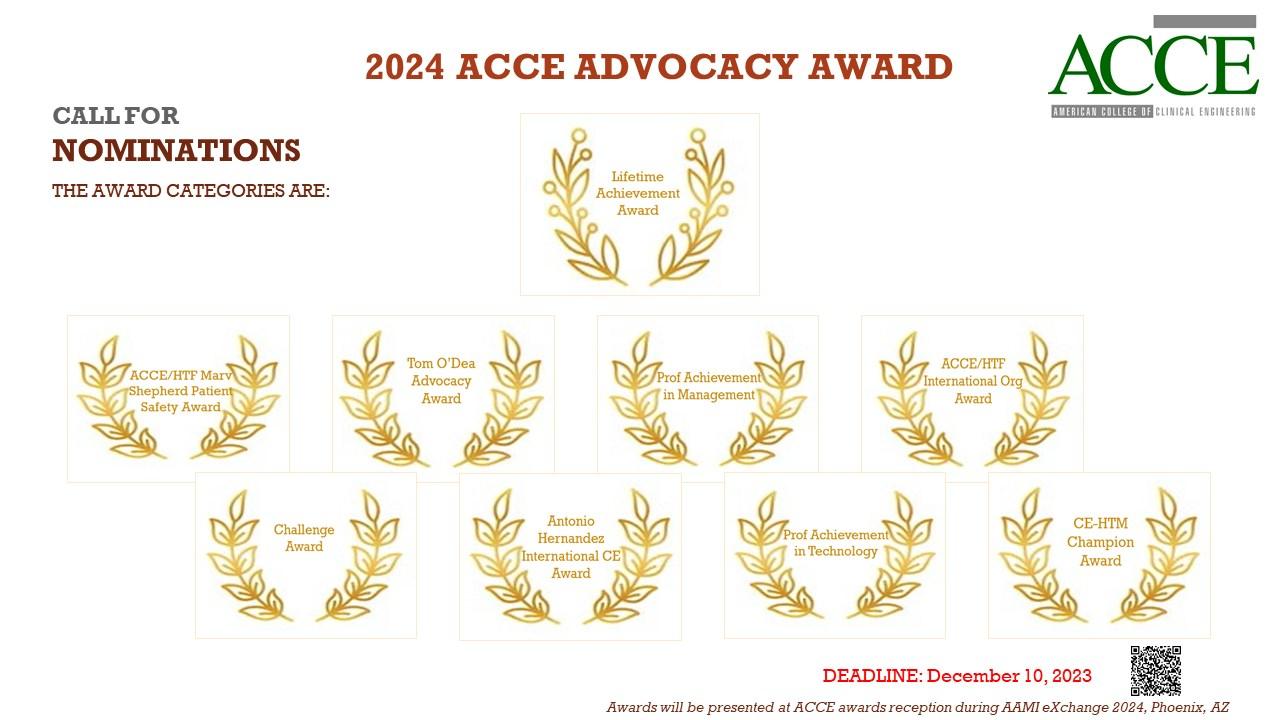
Submit the online nomination form by Sunday, December 10, 2023
Award Categories:
• Lifetime Achievement Award
• ACCE/HTF Marv Shepherd Patient Safety Award
• Challenge Award
• Tom O'Dea Advocacy Award
• Professional Achievement in Management/Managerial Excellence Award
• Professional Achievement in Technology/Professional Development Award
• Antonio Hernandez International Clinical Engineering Award
• ACCE/HTF International Organization Award
• CE-HTM Champion Award
For award criteria, please click here.
For past awards recipients, please click here
Click here to submit your nomination or use the QR code below.

Job Opportunities
See https://accenet.org/Mall/Pages/ JobOpportunities.aspx for Clinical Engineering job opportunities at the Veterans Healthcare Adminsitratrion (VHA) throughout the US, and the Hospital for Sick Children in Toronto, Ontario, Canada.
CALL FOR ABSTRACTS OR PAPERS
The CMBES Annual Conference is the premier event for biomedical engineering professionals in Canada. This conference offers a national forum for information exchange among researchers and practitioners working in the medical technology industry and biomedical engineering.

ThemainobjectiveofCMBEC46istoimprovecommunicationand encourage collaboration among all healthcare professionals through the presentation and discussion of new research and current challenges.
TheProgramCommitteeinvitesengineers,physicians,scientists, students, technicians and technologists to submit abstracts or papers for this important event. Scientific and technical contributions are welcome in, but not limited to, the following
areas:
• Biomaterials
• Biomechanics
• BiomedicalImageProcessing
• Biophotonics
• ClinicalEngineering
• EthicsandRegulations
• HealthInformatics
• Medical Devices: Development,Evaluationand Commercialization
• Neuroengineering
• PhysiologicalSystems/ Modeling
• Rehabilitation Engineering
• Robotics
• Sensorsand Instrumentation
• SignalProcessing
• SoftwareUsabilityTesting
• SyntheticBiology
• Telehealth
• TissueEngineering
Outstanding Research Competition
A short list of outstanding candidates will be selected by the Academic Committee upon submission. Papers and presentations ofthecandidatesontheshortlistwillbejudgedattheconference bytheCompetitionReviewCommittee.OnlyfullpapersbyCMBES members are eligible for this competition. The winner receives $2000.
Student Paper Competition
Students of biomedical engineering or technology, clinical engineering and related fields are invited to submit abstracts or papers. Only students who are members of CMBES will be eligible. The top three students judged to have presentedpapers of the highest quality will win a cash prize ($500, $300, $200).
Paper Submission Process
• Authors areinvitedtosubmita1-pageabstractor2-to4pagepaperorthroughthePKPonlinepapermanagement systemat https://proceedings.cmbes.ca/.
• You will be required to setup a PKP account when you log in thefirst time.
• The submission deadline is November 1, 2023 for the Abstracts or Papers.
• Abstracts or Papers will be subject to a critical review process by theAcademic Committee.
• Notificationofabstractorpaperacceptancewillbesentby February 1, 2024.
Presentation of abstracts or papers will be in podium or
poster sessions and the Program Committee reserves the right to decide on the medium to be used for each accepted paper.
Presentation and poster guidelines will be provided with notification ofacceptance.
Whether presented in a podium or poster session, submissions will be judged equally in the Outstanding Research and theStudent Paper Competitions.
Key Deadlines
November 1, 2023: Final date to submit papers or abstracts
February 1, 2024: Notification of paper acceptance
April 1, 2024: Early bird registration deadline
May 28–30, 2024: CMBEC46
Questions?
Visit www.cmbes.ca
cmbec.organizer@gmail.com
Journal of Clinical Engineering Subscriptions for ACCE Members
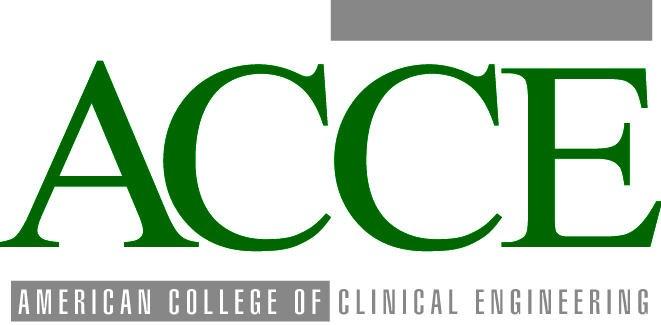
The Journal of Clinical Engineering is a compilation of articles, papers, and extensive manuscripts relevant to clinical/biomedical engineering or biomedical technology. Subject matter directly relates to the engineering or technology involved in patient care and treatment or technology in the broad field of health care delivery.
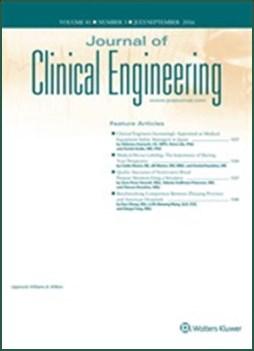


ACCE members receive a discounted subscription to the Journal of Clinical Engineering for only $99! (Originally $378). You must login to the ACCE website to view the code.
ACCE CALENDAR
https://accenet.org/NewsEvents/Pages/Calendar.aspx
October is Cybersecurity Awareness Month!
12 October 2023, 12:00 PM - 1:00 PM: 2023-2024 Educational Webinar Series, Session #2: Cybersecurity Passive Monitoring Systems - Lessons Learned from HDO and ISO Perspectives
Faculty: Eddie Myers (Crothall) & Keith Whitby (Mayo Clinic)
Pre-register here
21 - 26 October 2023: Global Engineering Day
Check ACCE News & Events Calendar for more details
24 October 2023, 12:00 PM - 1:00 PM: Complimentary Webinar. The Resilience Spectrum | The Pillars of MedTech Cybersecurity, sponsored by Claroty-Medigate
26 October 2023, 12:00 PM - 1:00 PM: 2023 Global Clinical Engineering Day - Women in Health Technology Panel Faculty: Introduction, Katherine Navarro. Panelists: Carol Davis-Smith, Katrina Jacobs, Krystal Santiago & Mayra Becerra. Moderator: Angelina Chiaracane. Click here to register.
30 - 31 October 2023, MD EXPO Fall 2023
Location: Caribe Royale Orlando, Florida
Check education sessions here: https://mdexposhow.com/ education/ and Click here to register
01 November 2023: Last day to submit your paper for the 46th CMBEC - CESO24
Location of May 2024 Conference: Doubletree by Hilton, Toronto, ON Click here to submit your paper online
04 - 18 November 2023: 2023 CCE Written Examination
09 November 2023, 12:00 PM - 1:00 PM: 2023-2024 Educational Webinar Series, Session #3: CMMS Success StoriesGetting Actionable Reports Out of Your Service Data.
Faculty: Barbara Maguire (ISS Solutions) & Arleen Thukral (VA)
*All times in Eastern Time Zone
The ACCE Board and Committee Chairs
President Kim Greenwood
President Elect Katherine Navarro
Vice President.................................................................... Qusai Shikari
Secretary Michele Manzoli
Treasurer Bhaskar Iduri
Member-at-Large..................................................................Jim Panella
Member-at-Large....................................................... Kevin Kreitzman
Member-at-Large Erin Sparnon
Member-at-Large Ashley O’Mara
Immediate Past President......................................................Ilir Kullolli
Advocacy Committee Chair Helen Cheong
CE Body of Knowledge/CCE Promo Chair Jennifer Nichols
Education Committee Co-Chairs....Juuso Leinonen & Mike Powers
Membership Committee Chair........................................ Amy Klemm
Nominations Committee Chair Ilir Kullolli
CE-HOF Nominations Review Committee Chair Arif Subhan
HTCC Chair ...........................................................Sudhakar Nagavalli
Secretariat Suly Chi

